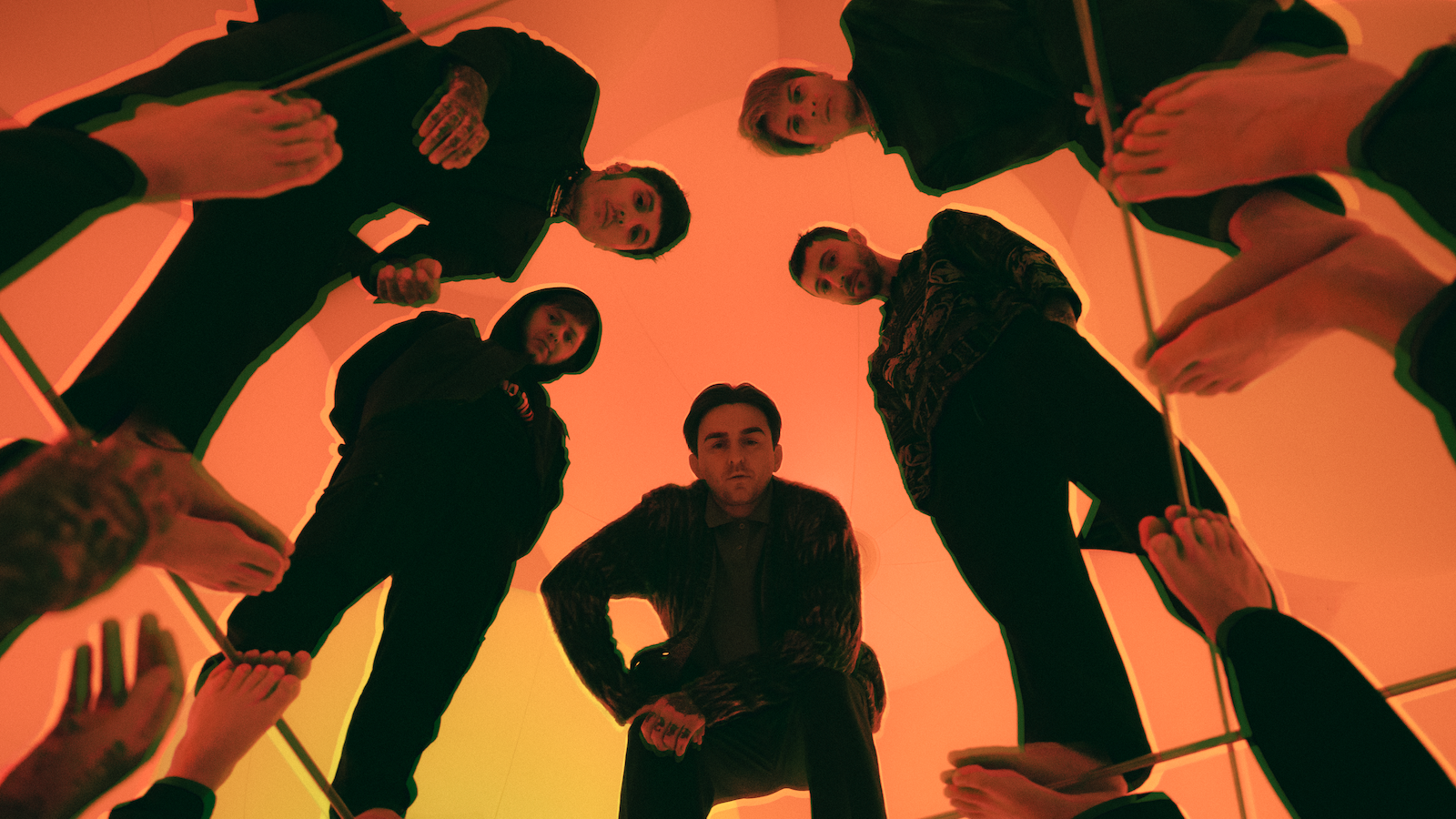Bring Me The Horizon’s Lee Malia: “I wanted to go as Slayer as I possibly could...”
Bring Me The Horizon continue to reinvent the core foundations of heavy music with another kaleidoscopic onslaught of beats and breakdowns.

Few bands have done as much to revolutionise the heavy music landscape as Bring Me The Horizon. The little Sheffield shredders that could have come a long way since the summery days of ’06, when they’d fill basements to the brim with mosh-hungry maniacs keen to get their teeth elbowed in to a soundtrack of garish, ghastly deathcore. They now reign with a frenzied fusion of post-rock riffs and underground electro beats, their sixth (and supposedly final) album Amo bringing them to an artistic peak most other genre-bending creatives could only dream of.
Since eschewing the traditional album campaign in favour of loose, off-the-cuff single and EP releases, Bring Me The Horizon have truly embraced their freedom in the music industry: their fans range from bonafide steel-crunching metalheads to dancefloor deviants in flower crowns – they can do whatever the f*** they want, knowing full well that a sea of kids will swarm at their knees to eat it up. And on their new nine-tracker Post Human: Survival Horror – the first in a four-part series of mini–LPs set to culminate in an epic new era for 2022 – the quintet truly push the limits of their artistic boundaries.
From drum ’n’ bass beatdowns to stadium-rock choruses, slithers of j-pop and industrial metal, there’s a whole world of erratic and explosive flourishes sandwiched between the frantic hardcore blasts of “Dear Diary” and the ethereal balladry of “Butterflies”. But according to guitarist Lee Malia, the record wasn’t some insanely convoluted practise in experimentation – in fact, it was one of their most lowkey, straight-to-the-punch record-making stints to date.
So you guys are calling this an EP, but at nine tracks over 35 minutes, it’s definitely a pretty weighty release. Is there a distinction you wanted to make between this as its own thing versus what you’d consider to be a BMTH ‘album’?
I guess we didn’t think it would be as long as it ended up – we were only thinking about doing four or five songs, so that’s why we called it an EP in the first place. The idea is to do four of these [Post Human] releases over the next year or so, and the next releases might be shorter, but with this one it just kind of made sense to keep writing and making songs. We really got into a flow with our songwriting, so we just carried on after we finished those first five songs. But I think it also helps that we’re calling these releases EP, because the next one might be five songs and 20 minutes long – we’re not going to do ‘albums’ anymore, because I feel like you’ve gotta commit to at least ten songs on an album. The EP format just gives you a bit more freedom.
How did the COVID pandemic shape how you approached this record as an artist?
Just working from home, the difference has been massive. We’ve always written songs together, even if it’s just been two or three of us at a time – we’ve always kind of gone somewhere, and for our last album, Amo, we’d built a room where we went every day and worked on it like a nine-to-five job. To just suddenly have to do it all from home, it’s so different. I did all my parts with my home setup – it’s all DIs and through a computer. So it was a very different way of working, but it turned out sounding really good. Luckily there’s a plugin that I have all my amp sounds on anyway, so I still had all my own tones on tap.
Especially over the last few records, BMTH have blurred the lines between heavy music and pop in ways that a lot of us wouldn’t have ever thought to be possible. And on this record in particular, it feels like you’ve really mastered the ebb and flow between those very contrasting sounds and styles. Was that something you were especially conscious of in the creative process?
We always knew “Dear Diary” was going to be the opener. There are a lot of those little bits on the CD where they almost sound like throwbacks to the way we used to do riffs, but they’re done in a more tasteful way – they’re woven in and out throughout the songs, rather than jammed in there as five-minute breakdowns and diminished scales. But the order of the CD always comes together near the end of the process, because it keeps changing. One minute we’ll be like, “Okay, this is the tracklisting!” And then we’ll completely change our minds, over and over, right up until the last minute. Because until you can sit back listen through it all as a whole thing, you can’t quite get your head around what order it should be in. But with this CD, the first song and the last song were obvious from the get-go, because they sound like what a first song and a last song should sound like.
Did it feel good to get back into shredder mode on “Dear Diary”?
Yeah man, it was cool. It didn’t have the solo there at first – Jordan [Fish, keys] actually recorded himself screaming down a microphone, like, “Nee-are-wee-ah-wow!” And he said, “Can you do something like this on this section?” So I was just like, “Yeah, alright.” I wanted to go as Slayer as I possibly could – I really tried to channel what I imagine they’d do for a crazy ten-second thrash solo. Yeah, it felt cool. I ended up using this super old guitar that I’d used to record Count Your Blessings with, because it was the only guitar I had left with a whammy bar on it. It was cool to do something that we wouldn’t have done for the last, like, three albums. It would have seemed so out of place on a record like Amo, but for some reason it just made sense to do it now.
Get The Pick Newsletter
All the latest guitar news, interviews, lessons, reviews, deals and more, direct to your inbox!
Can you tell us more about the guitars you used on this record?
I actually did a lot of the main riffs on a PRS baritone – it’s a hollowbody one with P-90s, and it almost sounds like a bass when you put the gain on it. It just sounds really heavy, which was honestly a bit surprising – I thought that since it’s a hollowbody with P-90s, it might sound weird, but it actually sounded really good. And then if I doubled stuff, I was using a solidbody ES-335 that I’ve got – a 1970s model. And then I used the Ibanez for all the shreddy bits.
With how experimental BMTH is at its core, do you often find yourself throwing a whole bunch of shit at the wall to see what sticks?
I guess less so on this record – I think it’s got a much more consistent sound than Amo did – that record was definitely where I lost my mind a bit, going mad with pedals and effects and weird stuff. In the studio it was just chains and chains of pedals, recreating synthesiser sounds and inventing totally new sounds. But this one is a lot more reined in, sound-wise. A lot of the core sound is just the tones I’ve used for ages, but when they’re mixed in with Jordan’s stuff and all the extra bits and pieces on the CD, it sounds like one big, solid in-your-face kind of sound.
Was that because you had a clearer vision of what you were looking for?
It just worked, combined with everything else that’s going on in the tracks. Because the synths are kind of bassy anyway, and there’s a lot of synths playing along with the riffs, if you get what I mean – they’re the same notes, just played a different way. They’re all gained-up synths with distortion on them, too, so with the baritone tuned super low it all just kind of fades into one sound. And that worked really well, so we decided to go with it for the whole CD.

Ellie Robinson is an Australian writer, editor and dog enthusiast with a keen ear for pop-rock and a keen tongue for actual Pop Rocks. Her bylines include music rag staples like NME, BLUNT, Mixdown and, of course, Australian Guitar (where she also serves as Editor-at-Large), but also less expected fare like TV Soap and Snowboarding Australia. Her go-to guitar is a Fender Player Tele, which, controversially, she only picked up after she'd joined the team at Australian Guitar. Before then, Ellie was a keyboardist – thankfully, the AG crew helped her see the light…
“The rest of the world didn't know that the world's greatest guitarist was playing a weekend gig at this place in Chelmsford”: The Aristocrats' Bryan Beller recalls the moment he met Guthrie Govan and formed a new kind of supergroup
Carlos Santana hospitalized following pre-show medical emergency


![[from left] George Harrison with his Gretsch Country Gentleman, Norman Harris of Norman's Rare Guitars holds a gold-top Les Paul, John Fogerty with his legendary 1969 Rickenbacker](https://cdn.mos.cms.futurecdn.net/TuH3nuhn9etqjdn5sy4ntW.jpg)







